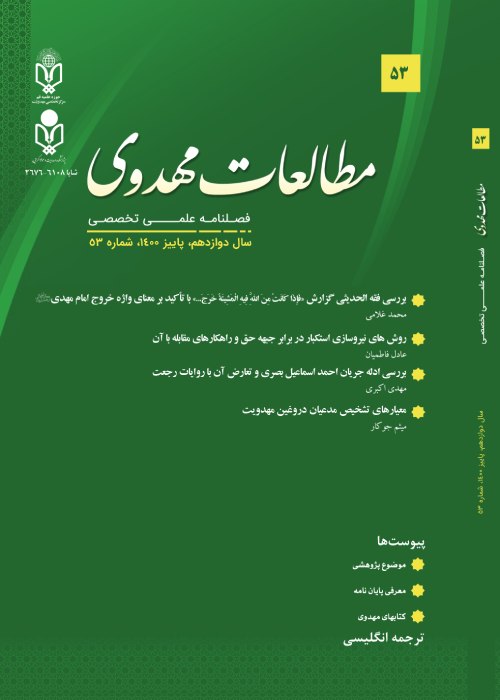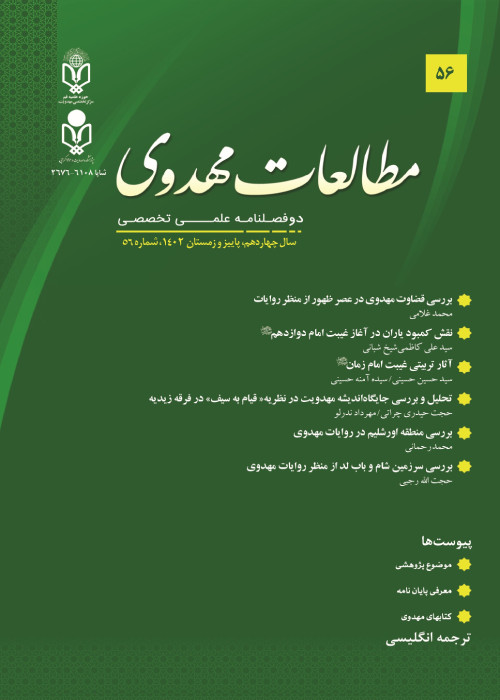فهرست مطالب

نشریه مطالعات مهدوی
پیاپی 53 (پاییز 1400)
- تاریخ انتشار: 1401/11/03
- تعداد عناوین: 6
-
صفحات 7-20
در برخی روایات، برای دوره آخرالزمان، تعابیری همسو شده است. گزارش مرحوم صفار و کلینی از آن جمله است که فهم معنای دقیق آن مستلزم توجه به برخی نکات است. بر این اساس در این مقاله به بررسی و تحلیل سندی، لغوی و معانی این گزارش و به طور ویژه معنای لفظ خروج حضرت حجت# با مشیت الهی میپردازیم. روایت مذکور با توجه به شرح حال راویان دارای دو طریق سندی موثق یا لااقل حسن است. علاوه بر این، تکرار آن در کتابهای متقدم و متاخر و عدم مخالفت محتوای آن با قرآن و سنت، اطمینان بر صدور این روایت از امام معصوم^ را تقویت میکند. مقاله پیش رو با روش توصیفی، تحلیلی و با استفاده از منابع کتابخانهای سامان یافته است. یافتهها نشان میدهد ایمه در انتخاب الفاظ و انتقال معنا دقت داشتند. از این رو واژهی به کار رفته در این روایت (خروج) با الفاظ «ظهور و قیام» تفاوت دارد، بدین صورت که ظهور آن حضرت، به خلاف خروج، امری دفعی است. همچنین میتوان بین ظهور و خروج به عنوان یک امر الهی و قیام به عنوان امر اجتماعی و فرآیند ظهور فرق گذاشت. فرق دیگر این است که واژه خروج به طور خاص با «مشیت الهی» پیوند خورده است؛ یعنی زمان ظهور، به اراده تکوینی خداوند تعیین و تقدیر میشود، سپس فرمان ظهور از جانب پروردگار به حضرت حجت صادر میگردد که این امر و فرمان الهی، خود، مصداق اراده تشریعی پروردگار است. بر این اساس میشود گفت، هم اصل ظهور و هم زمان آن فقط به اراده خداوند واقع میشود.
کلیدواژگان: خروج، ظهور، قیام، مشیت، کلینی، صفار، امام مهدی -
صفحات 21-41
از مهمترین اصول استراتژیک هر حکومتی این است که برای رسیدن به اهداف خاص خود، نیاز به تربیت و رشد نیرو دارد تا با به کارگیری نیروها به آرمانهای خود دست یابد و با دشمنان خود مقابله کند و کاربرد این اصل مهم در هر دو جبههی کفر و ایمان مشهود است. جبهه کفر در طول سالیان متمادی که هماره در حال مقابله با جبهه حق بوده، با روشهای مختلف به تربیت و پرورش نیرو پرداخته و با جبهه حق مقابله کرده است. شناخت روش نیروسازی دشمن میتواند فرصتی برای مقابله با آنان باشد تا توطیهها و خیانتهای آنان را خنثی کند. مقاله حاضر تلاشی برای شناخت روشهای جبهه استکبار در نیروسازی علیه نیروهای حق و مهدوی است تا علاوه بر شناخت شیوه نیروسازی آنان، این شیوه به عنوان پدافند در جبهه حق مورد بهرهبرداری قرار گیرد و با بهرهگیری از آن شاهد تقویت و پیشرفت جبهه حق باشیم. این پژوهش که با روش توصیفی تحلیلی و با استفاده از قرآن و متون حدیثی گردآوری شده، به برخی از روشهای نیروسازی استکبار (از قبیل استضعاف، تعبید، فریب، انکار حقایق، تحقیر، تفرقه) پرداخته است.
کلیدواژگان: روش نیروسازی، استکبار، جبهه حق، جامعه مهدوی -
صفحات 43-63
یکی از موضوعات اصلی در مباحث مهدویت، بررسی ادعاهای دروغین مدعیان مهدویت است. بر این اساس، تاکنون آثار متعدد و فاخری از سوی پژوهشگران تدوین یافته است. اما از آنجایی که این ادعاها و جریانات تداوم داشته و مدعیان نوظهوری بدنبال گمراه کردن بخشی از جامعه مسلمین بوده ضرورت دارد تا همواره محققان مسلمان با رصد علمی خود و با نگرشی نو به نقد این جریانها بپردازند. موضوع این تحقیق بهطور خاص بر جریان احمد اسماعیل بصری و نقد ادعای وی مبنی بر امامت دوازده مهدی است. احمد اسماعیل با روایات مشهوری مانند: دوازده مهدی، حدیث وصیت و روایات سیزده امام، سوءبرداشتهایی داشته است. بررسی روایات جایگاه دوازده امام در منابع روایی، مساله اصلی این پژوهش است. در متن پیشرو با کنار همگذاشتن روایات «دوازده مهدی» بعد از دوازده امام و روایات رجعت ایمه اطهار^ در آخرالزمان، ادعای وی تکذیب و تعارض بین روایات برطرف خواهد شد.
کلیدواژگان: فرق انحرافی، مهدویت، دوازده امام، جریان انحرافی، رجعت -
صفحات 65-80
در اعتقادات مسلمانان، مهدی موعود شخصیتی نجاتبخش است که تا قبل از قیامت ظهور خواهد کرد و جهان را از ستم و بیداد رهایی خواهد بخشید. در طول تاریخ اسلام بارها افرادی ادعا کردهاند که مهدی موعود# هستند و با این ادعا و تحریف مهدویت باعث انحراف اعتقادی مردم شدهاند. معیارهای متعددی برای تشخیص این ادعای دروغین همچون معیار اجتماعی، فرهنگی، سیاسی و غیره وجود دارد. این پژوهش با هدف شناسایی و بررسی معیارهای تشخیص کذب مدعیان دروغین مهدویت به روشی توصیفی _ تحلیلی میکوشد دادههای لازم را از منابع گوناگون جمعآوری کند. نتایج به دست آمده از تحلیل و ترکیب این دادهها نشان میدهد برخی از مهمترین معیارهای تشخیص مدعیان دروغین مهدویت عبارتاند از: تظاهر به زهد دینی و نقض آن، معنویتگرایی سکولار، تحریف و جعل و تقطیع در منابع و متون.
کلیدواژگان: ادعای مهدویت، معیارهای مهدویت، معنویت سکولار، سکولار - پیوست ها
-
صفحات 82-87
-
صفحات 88-91
-
Pages 7-20
In some Hadiths, there are a few aligned phrases describing the era of "the End of Time". The reports of the late Ṣaffār and Kulaynī are such that understanding their exact meanings requires paying more attention to some points. Based on this, in this paper, we will examine and analyze the document, vocabulary, and meanings of this narration, especially the meaning of the word "خاج " (the rising of Imam Mahdi by the will of Allah). According to the chain of transmitters, the mentioned Hadith has two authentic or at least acceptable sources. In addition, some factors such as its repetition in the earlier sources and later books and also the non-contradiction of its content with the Qur'an and the Sunnah, strengthen the certainty of issuing this narration from the side of the infallible Imams.
The present article is written by the descriptive-analytical method and using library resources. Studies have tended to show that the Imams were careful to choose the proper words for conveying the meaning; therefore, the word (خاوج) Arising used in this narration is different from two words Appearance and Uprising, in such a way that the appearance of Imam Mahdi (pbuh), unlike his arising, is a rapid thing. It is also possible to distinguish between the Imam’s appearance and arising (as the divine subject) with his uprising (as a social matter). Another difference is that the word (خاوج) Arising is specifically linked to “divine providence” i.e. the time of Appearance is determined by God’s existential will. Then Allah orders the Imam for the appearance, and this order is an example of God’s legislative will. Based on this, it can be said that both the appearance of the Imam and the time of Appearance will happen only by Allah’s will.Keywords: the arising, the appearance, the uprising, providence, Kulaynī, Ṣaffār, Imam Mahdi (pbuh) -
Pages 21-41
Among the most important strategic principles of any government is to achieve its specific goals by training and developing its forces in order to gain its goals by using the forces for confronting its enemies. The effectiveness of this important principle is highly visible in every two fronts of Right and Wrong. The front of infidelity and falsity, during many years that has been confronting the front of Truth, has always trained its forces by various methods in order to confront the Right front. To know the enemy’s methods of supplying forces can be an opportunity to confront them to neutralize their conspiracies and betrayals. The present article is an attempt to show the methods of the arrogant powers in supplying forces against the Right and Mahdavi forces, so that in addition to knowing their method of training the forces, this method can be used as a defense in the Truth front, and thereby, we witness the strengthening and development of the Right front. Using the descriptive-analytical method and based on the Qur'an and Hadith-texts, this research tries to deal with some of the methods of arrogance’s strengthening and supplying forces (such as subjugation, showing sth farfetched, denying facts, humiliation, disunity).
Keywords: methods of supplying forces, arrogance, Right front, Mahdic society -
Pages 43-63
Analyzing the false claimants of Mahdism and their allegations is one of the main subjects in the discourse of Mahdism. Regarding this, several prestigious works have been compiled by researchers in this field. But since these claims and movements have continued till now and novel claimants are trying to mislead a part of the Islamic community, it is necessary for Muslim researchers to continuously critique these straying movements through their scientific study and a new outlook. The objective of this research is specifically on Ahmad Ismāˈil al-Basri’s view and criticizing his claim about the Imamate of the Twelve Mahdis. Ahmad Ismāˈil has fallen into misunderstanding through some Hadiths like “the Hadith of Twelve Mahdis, the Hadith of Will, and traditions of Thirteen Imams”. The main issue of this research is the examination of the Twelve Imams’ position in Islamic narrative sources. In the present paper, by putting together the Hadiths of the "Twelve Mahdis" after the narrations of “Twelve Imams” and the narrations of “Coming (Rajˈat) the Imams at the End of Time”, his claim will be disallowed, and the conflict between the Hadiths will be eliminated.
Keywords: Ahmad al-Hasan, Mahdism, the Twelve Imams, straying movement, partial resurrection -
Pages 65-80
Muslim believe that the promised Mahdi (pbuh) is a savior and redeemer who will appear before the Day of Judgment and make the world free from oppression and injustice. Throughout the history of Islam, some liar individuals have claimed that they are the promised Mahdi, and based on this false claim and the distortion of Mahdism, they have caused people’s ideological deviation. There are various criteria to recognize these false claimants, such as social, cultural, political, etc. This research, in a descriptive-analytical way, aims to identify and examine the criteria of the false claimants of Mahdism, and tries to collect the necessary data from various sources. The obtained results from the analysis and combination of these data show that some of the most important criteria for identifying the false claimants of Mahdism are: To feign to be a faithful man and violate it, secular spiritualism, distortion, and forgery and to intersect sources and texts.
Keywords: Mahdism, false claimants, secular spirituality, secular


